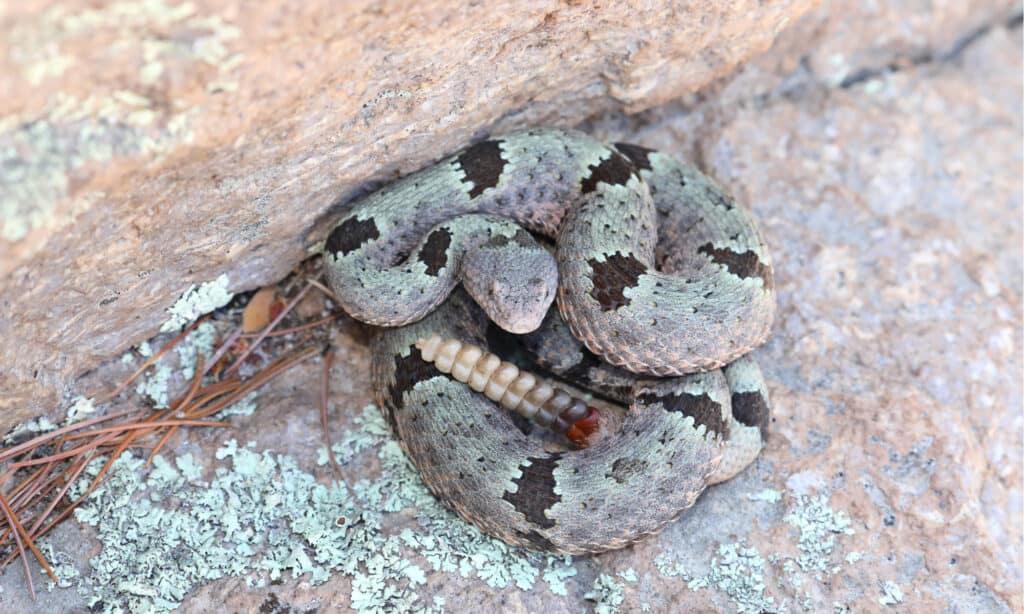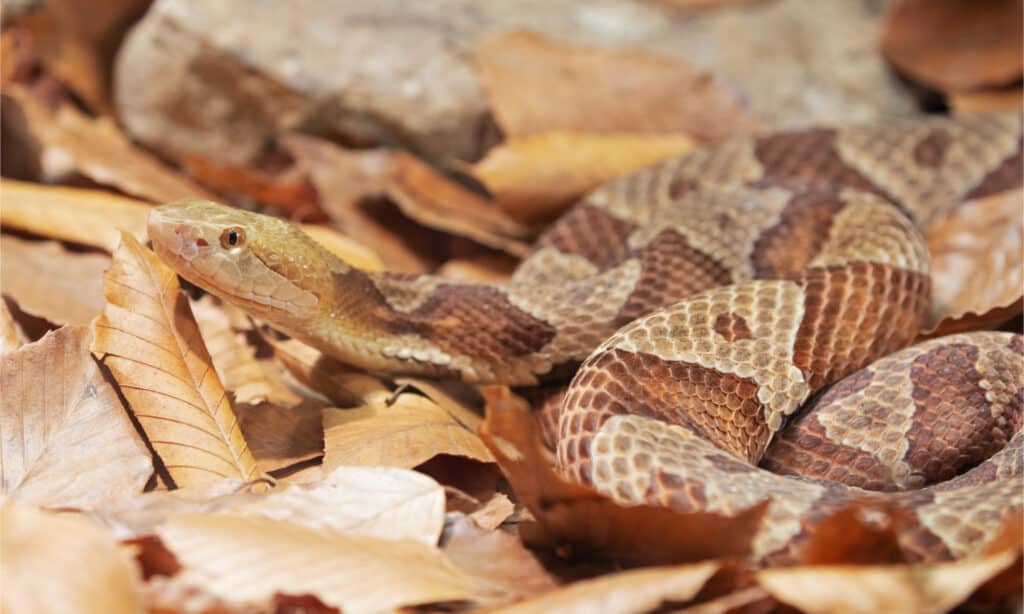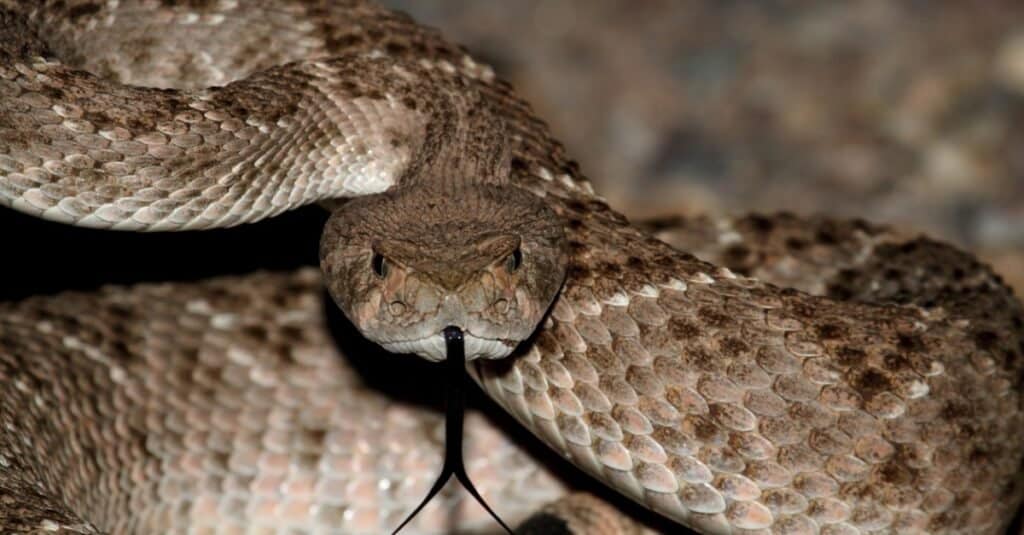While the state of Texas may be well-known for its abundant venomous snake population, few know that the state of Louisiana has its fair share of venomous species as well. In this guide to Texas vs. Louisiana venomous snakes, we’ll compare each of the venomous snake species from each state to see which one has more diversity.
Texas vs. Louisiana Venomous Snakes: Venomous Snakes in Texas
1. Prairie Rattlesnake
Classification: Crotalus viridis viridis
Several areas in Texas are home to the venomous Prairie Rattlesnake. This intriguing reptile is known for its distinctive rattle. The Prairie Rattlesnake’s venom is strong and largely hemotoxic, harming blood vessels, organs, and cells. If left untreated, its bite can result in excruciating pain, swollen tissues, and systemic consequences.
Despite being present in various areas of Texas, Prairie Rattlesnakes are not as widespread or numerous as some other venomous snake species in the region. When compared to snakes like the Western Diamondback Rattlesnake or Copperhead, encounters with and bites by Prairie Rattlesnakes are comparatively infrequent.
The Prairie Rattlesnake has a wide range of patterns and colors. Typically, their background color is pale tan to brownish, and they have dark brown or black blotches all over their bodies. These spots may be linked together to create a chain-like design. They have a triangular-shaped head, vertical pupils, and a segmented rattle that they utilize as a warning device at the end of their tails.
2. Broad-Banded Copperhead
Classification: Agkistrodon laticinctus
In some parts of Texas, there is a venomous snake species known as the Broad-Banded Copperhead. In Texas, Broad-Banded Copperhead bites are less frequent than those from other venomous snakes. However, while coming across them, vigilance is still suggested.
The look of these Copperheads is distinct. As their name implies, they have a copper-colored head. Additionally, their bodies are covered in broad bands of dark brown or reddish-brown hourglass shapes. Their heads include heat-sensitive pits that help them identify prey, and their scales have a rough texture. Even though its venom is strong, a Broad-Banded Copperhead bite can be successfully treated with the right medical care and antivenom, if required.
3. Rock Rattlesnake
Classification: Crotalus lepidus
The Texas state’s rocky ecosystems are home to the venomous Rock Rattlesnake. In the state, Rock Rattlesnake bites are not very prevalent.
These rattlesnakes stand out because of their stocky form and tiny, triangular-shaped heads. Their hue ranges from grayish-brown to reddish-brown, and they frequently have elaborate blotch or band patterns. They have a rattle at the end of their tails, and their scales are rough. Despite being venomous, Rock Rattlesnakes seldom attack people in Texas. This is probably because of the snakes’ solitary habitats and elusive habits. It is crucial to use caution and keep a safe distance from these snakes if you come across them, though.

The Rock Rattlesnake (pictured) is notoriously hard to spot due to how it camouflages with rocks.
©Glenn McCrea/Shutterstock.com
4. Northern Cottonmouth
Classification: Agkistrodon piscivorus
The Northern Cottonmouth is a kind of venomous snake that lives across Texas, especially in and around sources of water. Contrary to other venomous snakes, Northern Cottonmouth bites are quite rare in Texas, but it is still advisable to use caution when near them.
These snakes are distinguished by their dark coloring, which can range from olive to black, and sometimes have darker crossbands on their bodies. With a characteristic triangular-shaped head and vertical pupils, they are big and bulky in construction. They may exhibit their monicker cottony-white mouth lining as a warning indicator when threatened. Northern Cottonmouths are superb swimmers and semi-aquatic creatures that adapt well to wetlands. Due to the potentially harmful consequences of their venom, it is vital to seek medical assistance right once if you are bitten.
5. Texas Coral Snake
Classification: Micrurus tener
In some areas of Texas, there is a venomous snake species known as the Texas Coral Snake. Texas coral snake bites are very uncommon in the state since they are less numerous than other venomous snakes in terms of population.
These snakes are renowned for having an arresting and unique look. They have bands across their bodies that are vivid red, yellow, and black. The black bars divide the neighboring red and yellow bands from one another. Potential predators are warned off by this hue. The Texas Coral Snake has a slim body and a tiny head with rounded pupils. Due to the potentially harmful neurotoxic effects of their venom, it is imperative to seek quick medical assistance in the event that a bite does take place.
6. Eastern Copperhead
Classification: Agkistrodon contortrix
A venomous snake species called the Eastern Copperhead may be found in the eastern United States, including certain parts of Texas. Eastern Copperhead bites are very rare in Texas, but it is still advisable to use caution when hiking in areas where they have territories.
These snakes stand out thanks to their copper-colored heads and crossbands that resemble an hourglass on their bodies. In their native environments, the hue can range from reddish-brown to grayish-brown, making it possible to blend in. The skull of an Eastern Copperhead is triangular, and its pupils are vertical. They have quite the arresting look, but don’t try to touch them!

Northern Copperheads (pictured) might not bite humans often, but they are still very dangerous.
©DnDavis/Shutterstock.com
7. Timber Rattlesnake
Classification: Crotalus horridus
Several areas of the eastern United States, including sections of Texas, are home to the deadly Timber Rattlesnake. Compared to other venomous snakes, bites from timber rattlesnakes are relatively rare in Texas, although care should be taken when coming into contact with them.
These snakes are large in size, having a triangular-shaped head, and noticeable black stripes running down their bodies. The bands typically combine lighter tones of tan or yellow with dark brown or black. When they feel threatened, Timber Rattlesnakes employ the rattle at the end of their tails as a warning signal. Rapid medical assistance is essential to combat the possible side effects of their venom, which can include tissue damage and systemic issues.
8. Western Massasauga
Classification: Sistrurus catenatus tergeminus
In some parts of Texas, there is a venomous snake subspecies known as the Western Massasauga. Texas is home to a small number of Western Massasaugas, but it is still advisable to exercise caution if you come across an area known for them.
Small and stocky in size, these snakes feature a distinctive triangular-shaped head that is quite common among Texas snakes. Their bodies often have a background color of gray or light brown with a pattern of dark brown or black spots running down them. A row of black blotches running down the sides of their face is one distinguishing trait. The Western Massasaugas employ the little rattle at the end of their tails as a warning device. In the event of a bite, quick medical care is essential. (Have you picked up on a pattern here, yet?)
9. Western Diamondback Rattlesnake
Classification: Crotalus atrox
The most prevalent and common venomous snake in Texas is the Western Diamondback Rattlesnake. Compared to other dangerous snakes, Western Diamondback bites are much more frequent in Texas.
They have a characteristic diamond-shaped pattern on their backs, a rattle at the end of their tails, and are enormous, strong rattlesnakes. They feature vertical pupils, a triangular head shape, and heat-sensitive pits on their faces. The powerful venom of Western Diamondbacks is well recognized for its ability to inflict significant pain, tissue destruction, and other bodily consequences. Its venom predominantly targets the bloodstream. These snakes are expert predators who prey mostly on rodents and small animals. They coil, ratchet their tails, and, if provoked, may unleash a devastating bite when threatened. Always use caution when approaching these powerful reptiles!
10. Mojave Rattlesnake
Classification: Crotalus scutulatus
Several areas of Texas, especially in the western sections of the state, are home to the deadly Mojave Rattlesnake. Compared to other venomous snakes in the area, Mojave Rattlesnake bites are quite rare in Texas.
These rattlesnakes stand out thanks to their light brown to olive bodies and black, diamond-shaped markings that cover them. The presence of light-colored bands that span the black blotches, giving them a banded appearance, is one important diagnostic characteristic. Vertical pupils, a triangular head form, and a rattle at the end of their tails are all characteristics of Mojave Rattlesnakes. They are renowned for having venom that is extremely strong and may even paralyze the breathing system of animals that it bites. It’s critical to use caution and refrain from irritating these venomous snakes whenever possible.

The Mojave Rattlesnake (pictured) is mostly found in western Texas.
©iStock.com/SteveByland
11. Western Pygmy Rattlesnake
Classification: Sistrurus miliarius streckeri
A little venomous snake species called the Western Pygmy Rattlesnake is only found in certain parts of Texas. Fortunately, Western Pygmy Rattlesnake bites are quite rare in Texas. These rattlesnakes are short and thin, and they normally grow to be between one and two feet long. On a light brown or gray backdrop, they feature a striking pattern of dark brown or black blotches. The triangular-shaped skull, vertical pupils, and little rattle at the end of the tails of Western Pygmy Rattlesnakes are their defining features.
These snakes often prefer to stay hidden in foliage and are timid and solitary. Although their venom is strong, because of their tiny size, the amount normally injected in a bite is quite small. However, it’s crucial to use caution and keep these venomous snakes at bay.
Texas vs. Louisiana Venomous Snakes: Venomous Snakes in Louisiana
1. Eastern Diamondback Rattlesnake
Classification: Crotalus adamanteus
The southern United States, particularly Louisiana, is home to the venomous Eastern Diamondback Rattlesnake. Although they are not frequently encountered in Louisiana, Eastern Diamondback snakes and their bites should still be avoided.
These rattlesnakes are known for being the biggest venomous snakes in North America, frequently growing to be longer than six feet. On their backs, they exhibit a distinctive diamond-shaped pattern made of dark brown or black scales that are surrounded by lighter scales. Their large, triangular heads are covered in heat-sensing pits and venom-delivering teeth. The rattling at the end of the tails of Eastern Diamondbacks is used as a warning signal, so keep your ears open!
Eastern Diamondbacks are very venomous, and tiny animals make up the majority of their food. They are crucial ecological actors in the management of rodent populations. Unfortunately, human activities and habitat degradation pose serious challenges to their existence, emphasizing the need for conservation efforts for this iconic species.

The Eastern Diamondback Rattlesnake (pictured) is the largest species of venomous snake in the United States.
©Chase D’animulls/Shutterstock.com
2. Timber Rattlesnake
Classification: Crotalus horridus
Louisiana shares this species with Texas, making it one of many snakes on this list to live in both Texas and Louisiana. When it comes to Texas vs. Louisiana venomous snakes, there is quite a bit of overlap.
3. Pygmy Rattlesnake
Classification: Sisturus miliarius
A venomous snake species that may be found in different settings all around Louisiana is the Pygmy Rattlesnake. Although Pygmy Rattlesnake bites are not prevalent in Louisiana, caution should still be used when coming into contact with them.
These rattlesnakes are petite, usually measuring between one and two feet. On a backdrop of light brown or gray, they exhibit a distinctive pattern of black blotches. There is sometimes a rusty or reddish-brown stripe running down the middle of the back, and the blotches on the back may blend together or form a row. A triangular-shaped head, vertical pupils, and a short rattle are all characteristics of Pygmy Rattlesnakes.
These snakes are often timid and would rather hide than face danger. In comparison to bigger rattlesnake species, they have venom that is strong but less harmful to humans. Small prey including lizards, frogs, and rodents make up the majority of the diet of Pygmy Rattlesnakes. Like their Eastern Diamondback cousins, they are an essential component of local Louisiana ecology and serve a crucial role in managing rodent populations.
4. Eastern Copperhead
Classification: Agkistrodon contortrix
The Eastern Copperhead can also be found in Louisiana along with Texas. It also has populations all the way to Nebraska and even Massachusetts.
5. Texas Coral Snake
Classification: Micrurus tener
Another species shared with Texas, the Texas Coral Snake is more commonly found in the state of Texas but does have some populations throughout Louisiana.
6. Eastern Coral Snake
Classification: Micrurus fulvius
Louisiana and neighboring southern states are home to the deadly Eastern Coral Snake. Because Eastern Coral Snakes are typically non-aggressive and solitary, bites from these snakes are uncommon in Louisiana.
The body bands of Eastern Coral Snakes alternate between red, yellow, and black in a recognizable pattern. The black bars divide the neighboring red and yellow bands from one another. Their venomous nature is signaled by this coloring, though there are non-venomous snakes with similar patterns.
These snakes are tiny and blunt-headed, with round pupils. They have very dangerous neurotoxic venom that can harm the neurological system. Eastern Coral Snakes are typically placid and avoid conflict despite having venomous bites. Small snakes and the eggs of reptiles make up the majority of their food. The Eastern Coral Snake should be handled with caution; if it bites you, you should get medical help immediately.
7. Northern Cottonmouth
Classification: Agkistrodon piscivorus
The Northern Cottonmouth can be found in both the state of Texas and Louisiana.
Summary of Venomous Snakes in Texas and Louisiana
When it comes down to Texas vs. Louisiana venomous snakes, Texas has more species and subspecies of venomous snakes than Louisiana!
| Venomous Snakes in Texas | Venomous Snakes in Louisiana |
|---|---|
| Prairie Rattlesnake | Eastern Diamondback Rattlesnake |
| Broad-Banded Copperhead | Timber Rattlesnake |
| Rock Rattlesnake | Pygmy Rattlesnake |
| Cottonmouth | Eastern Copperhead |
| Texas Coral Snake | Texas Coral Snake |
| Eastern Copperhead | Eastern Coral Snake |
| Timber Rattlesnake | Northern Cottonmouth |
| Western Massasauga | |
| Western Diamondback Rattlesnake | |
| Mojave Rattlesnake | |
| Western Pygmy Rattlesnake |
The photo featured at the top of this post is © Paul S. Wolf/Shutterstock.com
Thank you for reading! Have some feedback for us? Contact the AZ Animals editorial team.






